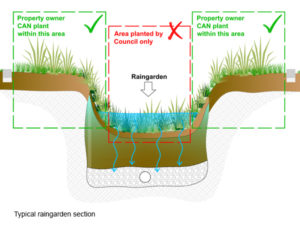 Have you heard about this new garden that looks fresh year-round, is easy to install, and adds value to your outdoor space? Well, that’s called a rain garden. A rain garden is a new kind of garden that gathers water from the rain, driveway, roof, and other curved surfaces. Thereby, the stormwater is not wasted by flowing into the local waterway or sewer yet utilized for your garden. Sounds good?
Have you heard about this new garden that looks fresh year-round, is easy to install, and adds value to your outdoor space? Well, that’s called a rain garden. A rain garden is a new kind of garden that gathers water from the rain, driveway, roof, and other curved surfaces. Thereby, the stormwater is not wasted by flowing into the local waterway or sewer yet utilized for your garden. Sounds good?
But the question is, how to make a rain garden for the better good? If you’ve been trying to figure this out, you’ve come to the right place.
Types of Raingardens
Some common types of rain gardens include:
- Above-ground planter boxes
- In-ground gardens
- Swales and more.
All of them are aimed to collect the rainwater and bring it to the garden.
Choose a Site for Raingarden
The very first step of building a rain garden is to devise a site. Make sure the rain garden space you select is at least 4 meters away from your home. An ideal rain garden site would be a low spot area in your yard that automatically collects most of the rain water leaks. Other than this, any area with a natural slope would just be fine.
Prepare the Raingarden Soil
After selecting the rain garden site, now is the right time to prepare soil for your rain garden. Follow these steps to create ideal soil conditions:
- Dig about 6 inches into the soil.
- The slope must slide gradually from the edges to the center of the rain garden area.
- Use the same soil that you dug to create a raised bunker on the edges. It will help to contain rainwater.
- Make sure not to dig the rain garden site for more than 6 inches. With a 6 inches deep rain garden, the rainwater will be absorbed within 2 to 7 days and mosquitos require 7-10 days to lay eggs.
- At the same time, if you want to contain fishes in the water, you can dig as deeper as 18 inches. Make sure to retain the area with plastic so that it doesn’t absorb in the soil.
If you’re concerned about the area, an ideal rain garden can be made on 100-300 square feet. But it’s totally fine if you’re short of the space. Many people create a rain garden based on the space available in their yard. Make sure the water coming from your roof, sidewalks, driveway, and other surfaces are directed towards the rain garden. In this way, you’ll have enough water to have an autopilot garden in the yard.
Best Plants for Raingarden
In any given condition, native plants are the best for rain gardens. They are able to withstand hard weather conditions and are able to overcome any difficulty in the growing process. And if you choose native plants, you don’t need fertilizers. Just a small weeding is enough for the perfect growth
One can also grow vegetables in the rain gardens using the same method. Keep following to learn more about flowers, planting, florists, and making your outdoor space a beautiful one.
